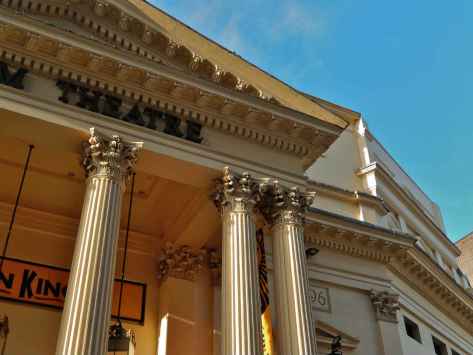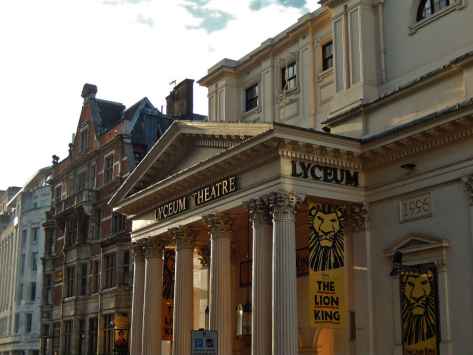Click on photos to enlarge.
The critics ate the Ballets Russes alive when they opened for a short, “low-priced,” season in London at the Lyceum Theatre on 21 Wellington St. at the end of 1926. All kinds of stuff about them going pop (in the local lingua of the time, of course). They’d lost their moxie. They were pandering to the public. That kind of stuff. Oh, really? I’ll bet you’d have a hell of a time finding a critic who didn’t fawn on The Lion King, which opened at this same venue in 1999 and is still running today! So much for critics, so much for standards, so much for taste! In fact, when you walk around London’s West End, as I did a few months ago, and you see all those cotton candy musicals gumming up the city’s stages, you wonder how London’s reputation as a great theater center has survived. But that’s just an aside. I’m here to think about the Ballets Russes today.
The show that really caught in the London critics’ collective craw in 1926 was The Triumph of Neptune. It premiered Dec. 3, 1926, and was composed by Lord Berners, choreographed by George Balanchine. It was the first work that Diaghilev ever commissioned from a British composer. It was considered populist and folkloric and decidedly beneath the great Ballets Russes. Here is what the critic for The Nation wrote:
“The excited giggles that greeted some of the more bizarre elements of the newer ballets betrayed a large sprinkling of a less highbrow audience. The season which opened at the Lyceum Theatre in November 1926 brought out an even motlier public, an enormous army of admirers, who make up an audience as unintelligent as any other, and apparently quite incapable of discriminating between one ballet and another.”
Oh, yes, where have I seen this before? If only the stupid public and the talentless artists would listen to us, the genius critics! But I keep digressing today…
Still, the razzes were not unanimous. In a friendly contemporary essay about the ballet, one scholar dug up something resembling a positive response and put it into context:
“In fact Diaghilev was as attuned to trends as ever,” writes Anne Witchard in “Bedraggled Ballerinas on a Bus Back to Bow: The ‘Fairy Business’.” “It was a craze for mid-century Victoriana among London’s so-called Bright Young Things that persuaded him to commission the eccentric peer and composer Lord Berners and his friend Sacheverell Sitwell to create the ballet score and libretto. The Triumph of Neptune was a combination of surreal pastiche, camp sentiment, and fierce nostalgia, and it prompted the normally anti-Diaghilev Daily Express critic, Hannen Swaffer, to state: ‘We saw at the Lyceum last night the beginnings of a British ballet.’ This was not quite what Haskell had meant. Where Haskell was referring to the artistic credibility of English ballet dancing as a nascent phenomenon thanks to Russian intervention, what Swaffer saw in The Triumph of Neptune was the rediscovery of an already credible native tradition. The flamboyant dandy-aesthetes of the 1920s embraced a ‘High-coloured Victorian England’ as wholeheartedly as pre-war Bloomsbury had rejected it, and Diaghilev’s company offered ways of making aesthetic connections to that tradition.”
The Triumph of Neptune was joined in rep by, among other titles, Igor Stravinsky’s The Firebird and Constant Lambert’s Romeo and Juliet. This latter work premiered in Monte Carlo a few months before London, and received a bit of a scandalous reception in Paris after Monte Carlo, but before London. The Parisians, apparently always quick to complain (or quick to give Diaghilev the publicity he craved) were unhappy that the pair of lovers in this version are swept away to safety on a new-fangled airplane rather than can kill themselves in the finale. Here, in a review of a CD containing both The Triumph of Neptune and Romeo and Juliet, is a description of the ballet as it unfolded on stage:
“This Romeo and Juliet is perhaps an irreverent treatment of Shakespeare’s tragedy, taking less than thirty-one minutes for performance. The first tableaux is ‘In a ballet classroom,’ in which the two principal dancers fall in love while practicing for the performance. The second tableaux is ‘At a rehearsal of scenes from Romeo and Juliet‘ in which the first meeting of the two lovers is depicted in a Sinfonia (3:03), the duel between Romeo and Tybalt by a Toccata (2:33), the balcony scene by a Musette (2:42), the death of Juliet by an Adagietto (1:59), and a Finale (3:22) after which the leading dancers do not take their curtain call—they have eloped by aeroplane.”
Romeo was danced by Serge Lifar (Serhiy Lyfar in transliteration from his native Ukrainian); Juliet by Alice (Alisa) Nikitina. You can see them in a photo on Pinterest.
A third ballet that played with the other two was a new version of Stravinsky’s The Firebird. As Alexander Golovin’s sets and Leon (Lev) Bakst’s costumes to the famous 1910 production had been damaged beyond repair, Diaghilev had Natalya Goncharova create a new environment for the piece. (You can see a nice shot of her backdrop here.) According to The London Stage 1920-1929: A Calendar of Productions, Performers, and Personnel, The Firebird opened Nov. 22, 1926, and played 10 times through Dec. 11. It used the original Michel Fokine (Mikhail Fokin) choreography, and starred Serge Lifar as Ivan Tsarevich and Lydia Lopokova (Lidia Lopukhova) as the Firebird. Chatty birds even today tell us that Lopokova did not like working with Lifar, but she put on a game face and did it anyway.
There were apparently several other works that joined these main pieces during the London “low-priced” season. The fine AusStage website informs us that on Thursday, Nov. 25, the following combination of ballets and symphonic pieces opened: The Three-Cornered Hat, The Firebird, L’Apres Midi D’un Faune, and Prince Igor, plus the interludes of Largo by Gemignani (first performance in England), Jeux en Plein Air by Tailleferre (first performance in England) and Scherzo by Borodin.
Look at all that cheap, populist stuff! Right here at the Lyceum, November and December 1926.









